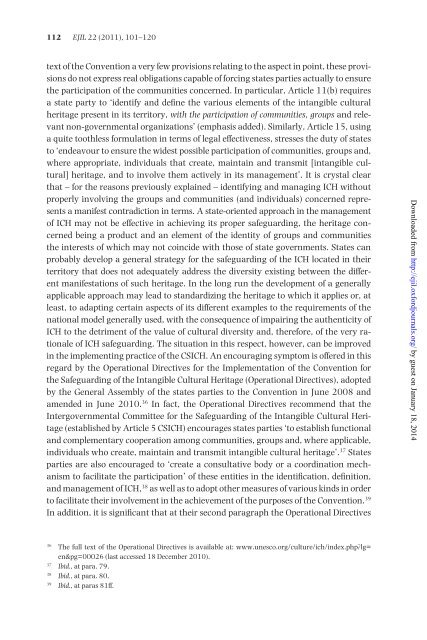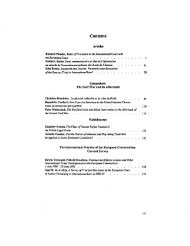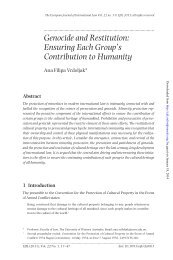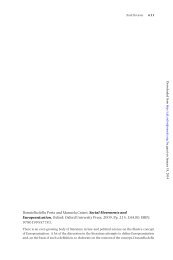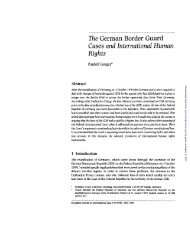Intangible Cultural Heritage - European Journal of International Law
Intangible Cultural Heritage - European Journal of International Law
Intangible Cultural Heritage - European Journal of International Law
You also want an ePaper? Increase the reach of your titles
YUMPU automatically turns print PDFs into web optimized ePapers that Google loves.
112 EJIL 22 (2011), 101–120<br />
text <strong>of</strong> the Convention a very few provisions relating to the aspect in point, these provisions<br />
do not express real obligations capable <strong>of</strong> forcing states parties actually to ensure<br />
the participation <strong>of</strong> the communities concerned. In particular, Article 11(b) requires<br />
a state party to ‘identify and define the various elements <strong>of</strong> the intangible cultural<br />
heritage present in its territory, with the participation <strong>of</strong> communities, groups and relevant<br />
non-governmental organizations’ (emphasis added). Similarly, Article 15, using<br />
a quite toothless formulation in terms <strong>of</strong> legal effectiveness, stresses the duty <strong>of</strong> states<br />
to ‘endeavour to ensure the widest possible participation <strong>of</strong> communities, groups and,<br />
where appropriate, individuals that create, maintain and transmit [intangible cultural]<br />
heritage, and to involve them actively in its management’. It is crystal clear<br />
that – for the reasons previously explained – identifying and managing ICH without<br />
properly involving the groups and communities (and individuals) concerned represents<br />
a manifest contradiction in terms. A state-oriented approach in the management<br />
<strong>of</strong> ICH may not be effective in achieving its proper safeguarding, the heritage concerned<br />
being a product and an element <strong>of</strong> the identity <strong>of</strong> groups and communities<br />
the interests <strong>of</strong> which may not coincide with those <strong>of</strong> state governments. States can<br />
probably develop a general strategy for the safeguarding <strong>of</strong> the ICH located in their<br />
territory that does not adequately address the diversity existing between the different<br />
manifestations <strong>of</strong> such heritage. In the long run the development <strong>of</strong> a generally<br />
applicable approach may lead to standardizing the heritage to which it applies or, at<br />
least, to adapting certain aspects <strong>of</strong> its different examples to the requirements <strong>of</strong> the<br />
national model generally used, with the consequence <strong>of</strong> impairing the authenticity <strong>of</strong><br />
ICH to the detriment <strong>of</strong> the value <strong>of</strong> cultural diversity and, therefore, <strong>of</strong> the very rationale<br />
<strong>of</strong> ICH safeguarding. The situation in this respect, however, can be improved<br />
in the implementing practice <strong>of</strong> the CSICH. An encouraging symptom is <strong>of</strong>fered in this<br />
regard by the Operational Directives for the Implementation <strong>of</strong> the Convention for<br />
the Safeguarding <strong>of</strong> the <strong>Intangible</strong> <strong>Cultural</strong> <strong>Heritage</strong> (Operational Directives), adopted<br />
by the General Assembly <strong>of</strong> the states parties to the Convention in June 2008 and<br />
amended in June 2010. 36 In fact, the Operational Directives recommend that the<br />
Intergovernmental Committee for the Safeguarding <strong>of</strong> the <strong>Intangible</strong> <strong>Cultural</strong> <strong>Heritage</strong><br />
(established by Article 5 CSICH) encourages states parties ‘to establish functional<br />
and complementary cooperation among communities, groups and, where applicable,<br />
individuals who create, maintain and transmit intangible cultural heritage’. 37 States<br />
parties are also encouraged to ‘create a consultative body or a coordination mechanism<br />
to facilitate the participation’ <strong>of</strong> these entities in the identification, definition,<br />
and management <strong>of</strong> ICH, 38 as well as to adopt other measures <strong>of</strong> various kinds in order<br />
to facilitate their involvement in the achievement <strong>of</strong> the purposes <strong>of</strong> the Convention. 39<br />
In addition, it is significant that at their second paragraph the Operational Directives<br />
Downloaded from http://ejil.oxfordjournals.org/ by guest on January 18, 2014<br />
36<br />
The full text <strong>of</strong> the Operational Directives is available at: www.unesco.org/culture/ich/index.php?lg=<br />
en&pg=00026 (last accessed 18 December 2010).<br />
37<br />
Ibid., at para. 79.<br />
38<br />
Ibid., at para. 80.<br />
39<br />
Ibid., at paras 81ff.


